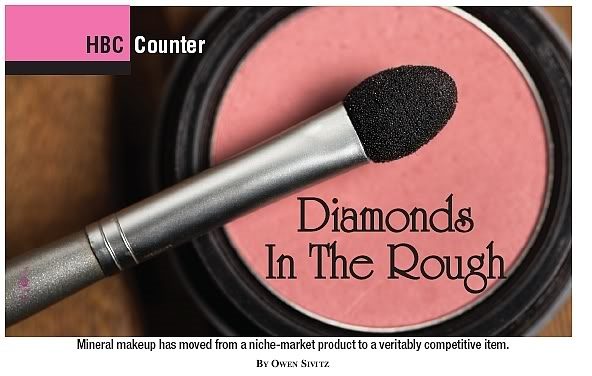Tired of worrying that your cosmetics might actually be detrimental for your skin? So are the millions of American women who have begun purchasing mineral-based makeup (MBM), thereby helping this product category become one of the hottest trends in cosmetics.
Tired of worrying that your cosmetics might actually be detrimental for your skin? So are the millions of American women who have begun purchasing mineral-based makeup (MBM), thereby helping this product category become one of the hottest trends in cosmetics. MBM has moved from a niche-market product to a veritably competitive item over the past several decades. In recent years, the movement toward natural products has thrust MBM into the spotlight as more and more customers seek awareness of what they put in and on their bodies.
Why Mineral-Based Makeup?
Sales in the beauty care industry grew by 5% last year according to Euromonitor, a global market research firm that monitors data and trends in cosmetics. According to the firm, demand for natural and organic products drove much of this growth. Skincare, the industry’s largest sector, saw worldwide sales of over $60 billion in 2006. In 2000, the U.S. market for natural and organic products was $190 million (1). In the years since, that figure has risen 67%, now topping $318 million. It is easy to see that consumers are leaning toward products containing natural ingredients in everything from beverages to cosmetics. In a Wall Street Journal interview, Euromonitor senior research analyst Virginia Lee said, “As consumers become more interested in what they’re taking into their bodies, they’ve also become more interested in what they’re applying topically to the body”(1).
Cosmetics formulated with minerals have been an important part of this movement. The focal point for consumers is about what MBM contains as well as what it does not. MBM does not include any preservatives—there is no need since bacteria cannot grow in an inorganic substance. They are almost all fragrance-free, which is an important issue for clients with sensitive skin, as chemical fragrance is often the culprit in skin allergies from cosmetics. Many other negative characteristics found in traditional makeup are absent from MBM such as oils, dyes, waxes and talc, which can clog pores and irritate sensitive skin membranes.
Key Clientele
A common complaint related to traditional makeup is that it contains unhealthy chemicals and is often comedogenic, meaning that it can clog facial pores. This can lead to unsightly blemishes, redness or irritation—not exactly what a beauty conscious consumer is looking for! For years, dermatologists have recommended MBM to patients suffering from acne due to the low instances of sensitivity. Clients with rosacea have reported that MBM offers good coverage for a ruddy complexion, with little to no instance of increased inflammation. “Makeup sensitivity is often the result of synthetic dyes, fragrances, and preservatives, so any makeup that eliminates these is going to eliminate some of the related problems,” says Kathryn Frew, M.D., a dermatologist at Juva Skin and Laser Center and MediSpa in New York City (3). The presence of zinc oxide and titanium dioxide seem to support many company’s claims, as these minerals have been shown to be natural sunscreens as well as possessing anti-bacterial and anti-inflammation properties (2). Despite these benefits, clients should be aware that different skin types could have varied reactions to cosmetic ingredients, even those that contain all-natural ingredients.
The Makeup Of Your Makeup
Here is a list of some common ingredients found in MBM:
• Titanium Dioxide: High-coverage mineral whitener with natural UV protection.
• Zinc Oxide: Because it absorbs both UVA and UVB rays of light, zinc oxide is often used as a natural sunscreen.
• Iron Oxide: Adds natural color.
• Serecite: This translucent mineral makes skin feel silky.
• Mica: Mica is a mineral that sparkles and creates the illusion of radiant skin.
• Kaolin Clay: Offering high absorbance and adhesion, this creamy mineral is used in small amounts to increase oil absorption and adhesion. Clients should avoid using much of this on dry skin types (3, 4).
MBM, in its intended form, comes directly from the minerals of earth. For this reason it has become popular enough to attract the attention of many major cosmetic labels (both conventional and natural). However, some brands have opted to add fillers, preservatives and other chemical additives to their line. Before stocking your shelf, be sure to read the ingredients of each particular brand to ensure it is an all-natural, skin-friendly product. WF
References
1. M. Hennessey, “Organic Cosmetics Break Out,” July 25, 2007, Global Policy Innovations, www.policyinnovations.org/ideas/briefings/data/organic_cosmetics, accessed November 24, 2008.
2. L. Petrecca, “Cosmetic Companies Tout Mineral Based Makeup,” USA Today, March 24, 2008, www.usatoday.com/money/advertising/adtrack/2008-03-23-mineral-makeup_N.htm, accessed November 24, 2008.
3. C. Bouchez, “The Lowdown On Mineral Makeup,” www.webmd.com/skin-beauty/features/the-lowdown-on-mineral-makeup, accessed November 24, 2008.
4. S. Strausfogel, “Mineral Magic: Is it Skin Care or Makeup,” Better Nutrition, May 2007.
Published in WholeFoods Magazine, January 2009









